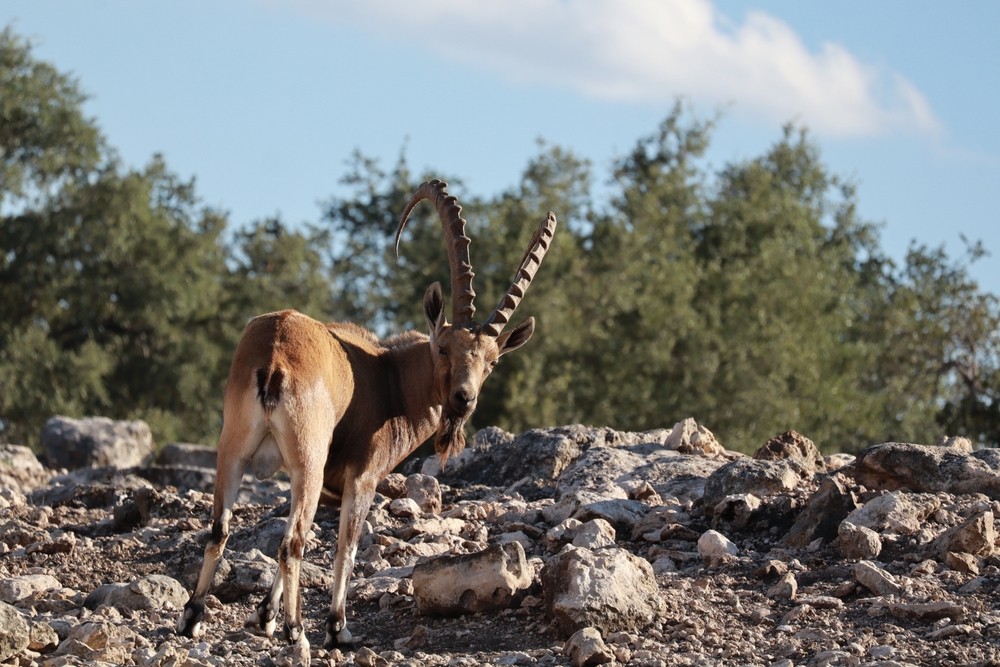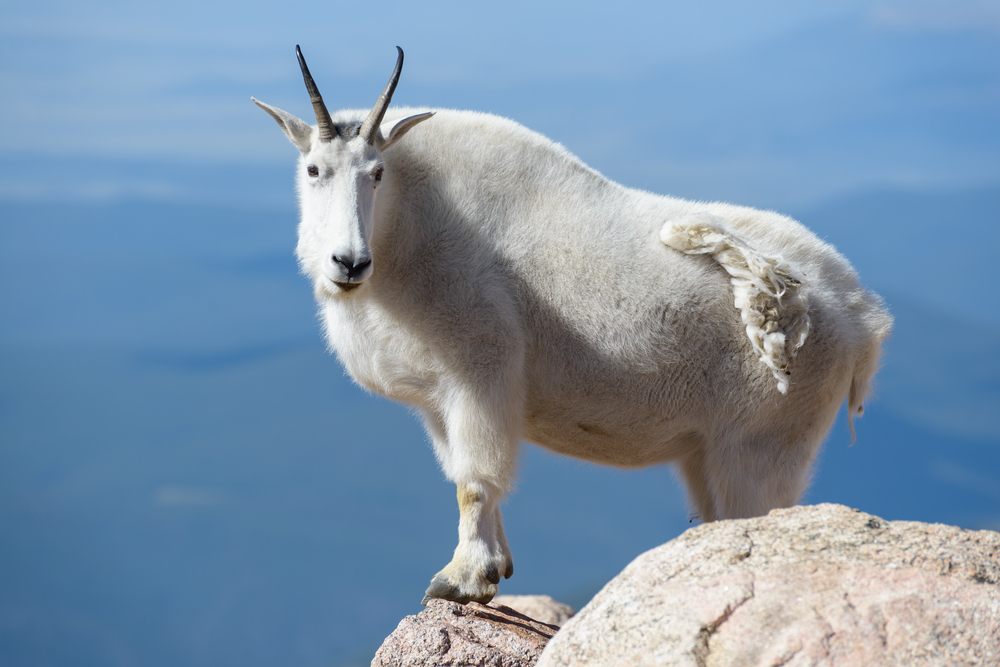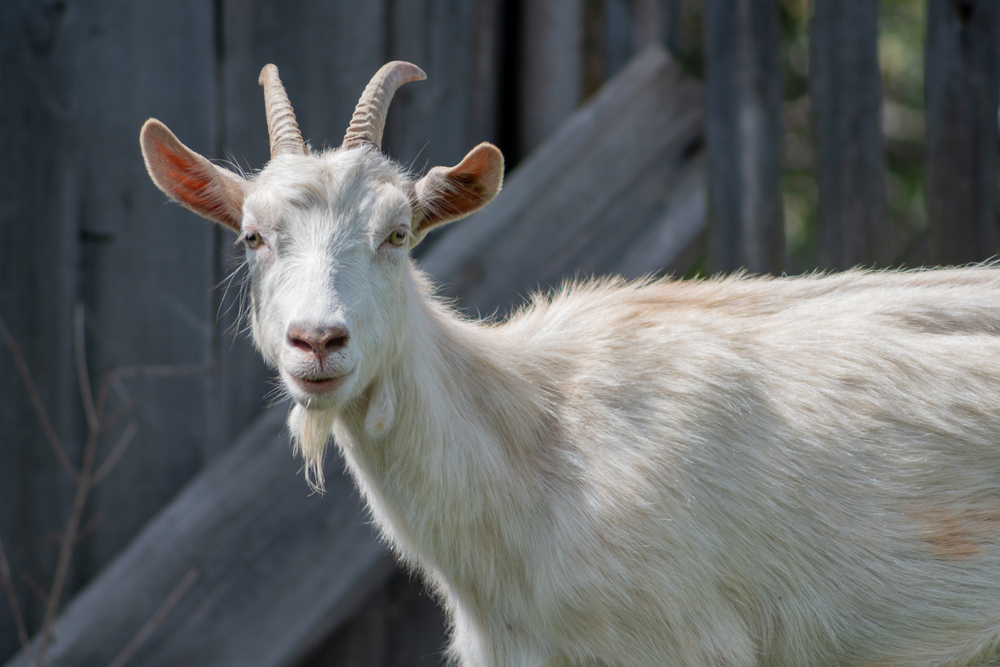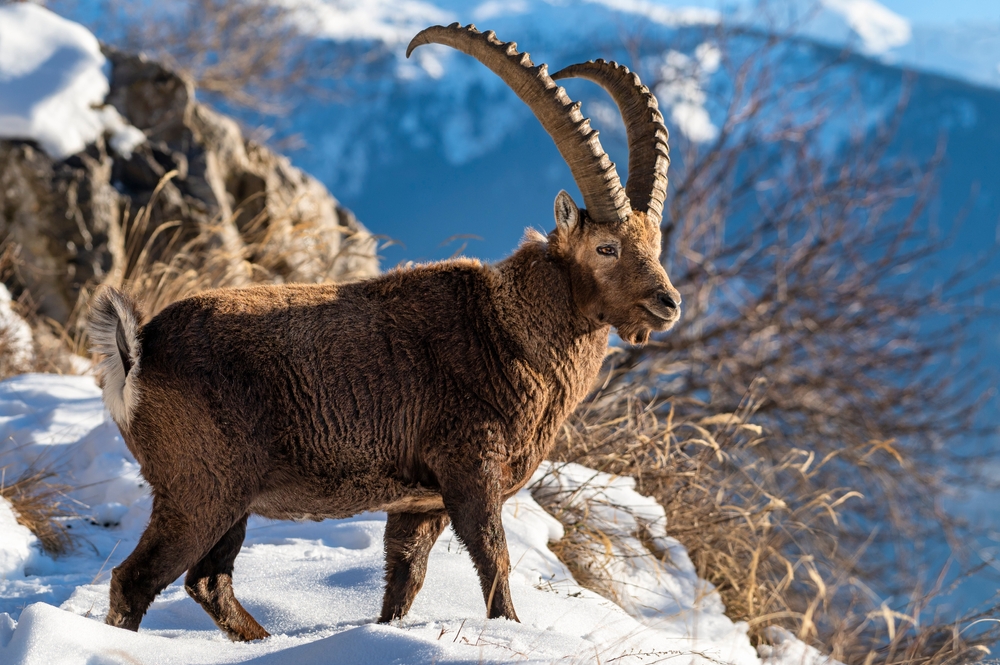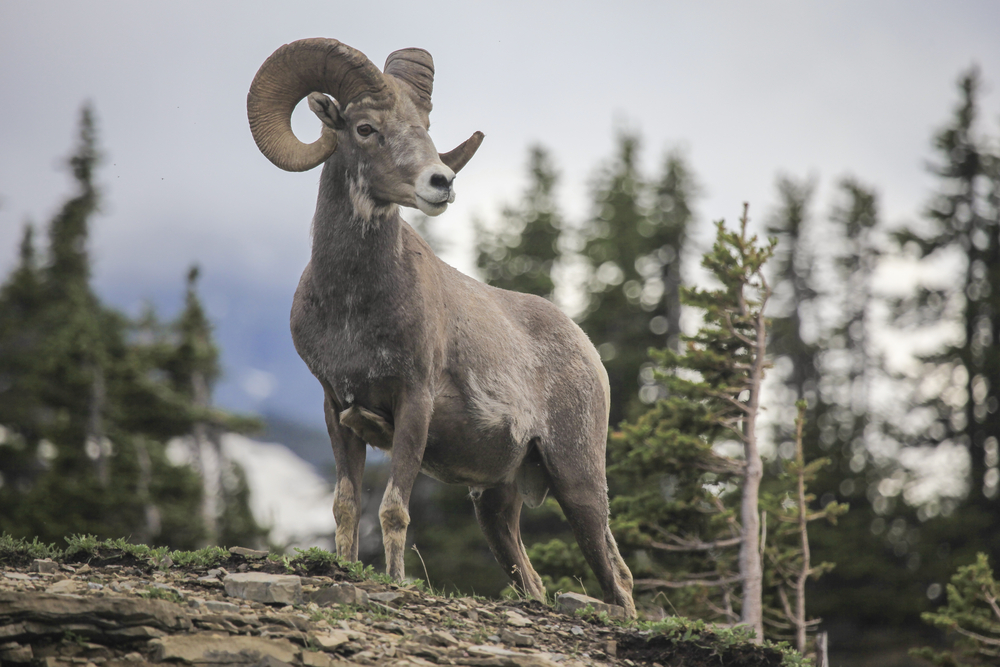The Nubian ibex (Capra nubiana) is most closely related to other wild goats in the genus Capra, particularly the Alpine ibex (Capra ibex) and the Siberian ibex (Capra sibirica). It also shares ancestry with the domestic goat (Capra hircus).
About
The Nubian ibex (Capra nubiana) is a wild goat species adapted to the arid, rocky deserts and mountains of North Africa and the Middle East. It belongs to the family Bovidae, which also includes antelope, cattle, sheep, and domestic goats. Found in countries such as Egypt, Sudan, Israel, Jordan, Saudi Arabia, and Yemen, the Nubian ibex is superbly adapted to hot, dry environments where water and vegetation are scarce.
Males (bucks) are larger than females (does), weighing 50–75 kg (110–165 lbs) compared to 25–40 kg (55–88 lbs) for females. The most striking feature of males is their long, backward-curving horns, which can reach up to 1 meter (39 inches) in length and have distinct ridges along the front edge. Females have shorter, thinner horns. Their coat is short and light tan, blending with the desert landscape, with white undersides and black markings on the legs and face.
Nubian ibexes are expert climbers, using their split hooves and rubbery foot pads to navigate steep cliffs and rocky slopes where predators have difficulty following. They feed primarily on sparse desert vegetation, including grasses, herbs, shrubs, and leaves, and can go for long periods without drinking, obtaining moisture from plants.
They are social animals, with females and young forming small herds, while males often live alone or in bachelor groups outside the breeding season. The rut occurs in late autumn, during which males engage in horn-clashing contests for dominance. Kids are usually born in spring when food is more abundant.
Although once more widespread, the Nubian ibex has declined due to overhunting, habitat loss, and competition with livestock. It is currently listed as Vulnerable by the IUCN, though protected populations exist in several reserves and national parks.
Physical Characteristics
The Nubian ibex (Capra nubiana) is a desert-dwelling wild goat adapted to hot, arid, and rocky environments in the Middle East and northeastern Africa:
-
Coat: Short, sleek hair that is light sandy-brown to tan, blending well with desert rock. The underbelly, inside of legs, and rump are whitish, while a dark stripe runs along the back from shoulders to tail.
-
Head: Narrow face with large, expressive eyes and short, pointed ears.
-
Horns: Both males and females have horns, but males’ are massive, thick, and strongly curved backward, reaching up to 3 ft (1 m) in length with pronounced ridges. Females’ horns are shorter, thinner, and less curved.
-
Body: Lean but muscular frame built for agility, with a deep chest and strong shoulders.
-
Legs: Long and slender yet powerful, with cloven hooves featuring rough-textured pads for grip on rocky surfaces.
-
Tail: Short, ending in a dark tuft of hair.
Size:
-
Length (Body): Approximately 3.6 to 4.6 ft (1.1 to 1.4 m) from head to rump.
-
Shoulder Height: Around 2.3 to 2.6 ft (0.7 to 0.8 m).
Weight:
-
Adult Female: Typically 55 to 88 lbs (25 to 40 kg).
-
Adult Male: Usually 110 to 150 lbs (50 to 68 kg).
The Nubian ibex’s light coat, long legs, and impressive horns make it well-adapted to the steep cliffs, wadis, and rocky slopes of arid desert mountains.
Reproduction
The Nubian ibex has a breeding cycle timed to ensure that kids are born during the most favorable desert season for survival:
-
Mating and Breeding Season:
-
Breeding occurs during the rut in late fall to early winter (October to January).
-
Males compete for females through horn clashes, chasing, and dominance displays, with larger, more experienced males usually winning breeding rights.
-
-
Gestation:
-
The gestation period lasts about 150 to 160 days (approximately 5 months).
-
-
Birth and Kidding:
-
Most births take place in spring (March to May), when temperatures are mild and desert vegetation is more abundant.
-
Usually a single kid is born, though twins are not uncommon in favorable conditions.
-
-
Kid Characteristics at Birth:
-
Newborns weigh about 5 to 8 lbs (2.3 to 3.6 kg).
-
They are precocial—able to stand, nurse, and follow their mother within hours, essential for avoiding predators.
-
-
Maternal Care:
-
Females often choose remote cliff ledges or rocky outcrops for birthing to minimize predator access.
-
Kids nurse for 3 to 6 months, gradually eating vegetation as they grow.
-
-
Maturity and Breeding Readiness:
-
Females reach sexual maturity at 2 to 3 years.
-
Males may be sexually mature at 3 years but often do not successfully breed until 5 to 6 years, when they can challenge dominant males.
-
The Nubian ibex’s synchronized breeding, cliffside birthing strategy, and rapid kid mobility are key adaptations for survival in the harsh desert mountain environment.
Lifespan
In the Wild:
Nubian ibex typically live 10 to 15 years, with females often living longer than males due to lower physical stress outside of the rut.
In Captivity:
In wildlife reserves and zoos with consistent food, water, and veterinary care, Nubian ibex can live up to 17–20 years.
Threats to Longevity:
-
Predation: Leopards, wolves, caracals, and large birds of prey may target kids; adult males are less vulnerable but can still fall victim to large predators.
-
Environmental Stress: Prolonged droughts and scarce forage in desert habitats can weaken individuals and reduce survival rates.
-
Rut-Related Stress: Males expend significant energy during the breeding season, which can shorten lifespan over time.
-
Human Impact: Hunting, habitat loss, and competition with livestock for grazing have reduced populations in some areas.
The Nubian ibex’s adaptations for heat tolerance, sure-footedness, and predator evasion allow it to thrive in some of the harshest climates on Earth, but environmental pressures still limit its lifespan in the wild.
Eating Habits
The Nubian ibex is an herbivorous browser and grazer adapted to the sparse vegetation of arid mountain habitats:
-
Primary Diet:
-
Prefers shrubs, bushes, and desert herbs, including acacia leaves, capers, and saltbush.
-
Will graze on grasses when available, especially after seasonal rains.
-
Consumes wild fruits, pods, and seeds when in season.
-
-
Foraging Adaptations:
-
Can survive on vegetation with low moisture content, obtaining much of its water from plants.
-
Well-adapted to feed on tough, thorny plants using its nimble lips and strong teeth.
-
-
Seasonal Diet Shifts:
-
Spring: Takes advantage of fresh green growth after winter rains.
-
Summer/Dry Season: Relies heavily on drought-resistant shrubs, woody plants, and dry grasses.
-
-
Feeding Behavior:
-
Active foragers in the cooler hours of morning and late afternoon, resting in shade during midday heat.
-
Often climbs steep cliff faces to access vegetation inaccessible to other herbivores.
-
The Nubian ibex’s ability to thrive on sparse, dry, and thorny vegetation is a key factor in its survival in some of the most rugged desert mountain ecosystems in the world.
Uniqueness
The Nubian ibex (Capra nubiana) is a desert-adapted wild goat with a combination of features that make it exceptional among mountain ungulates:
-
Heat Adaptation: Light-colored coat reflects sunlight, and its ability to survive on minimal free water allows it to endure extreme desert heat.
-
Iconic Horns: Males possess long, thick, ridged horns curving backward up to 3 ft (1 m), used in dominance battles and as a visual display of strength.
-
Cliffside Agility: Exceptional climbers, capable of navigating sheer rock faces to escape predators and reach food.
-
Minimal Water Dependence: Can go for long periods without drinking, deriving most moisture from plants.
-
Social Structure: Lives in gender-segregated herds most of the year, with males joining females only during the rut.
-
Predator Evasion: Uses inaccessible cliff ledges as safe zones for resting, birthing, and avoiding predators.
-
Cultural Significance: Featured in ancient Middle Eastern art and mythology, often symbolizing vitality and survival.
The Nubian ibex’s blend of desert endurance, climbing skill, and striking appearance makes it one of the most distinctive and admired wild goats in the world.
Be the First to Share Photos of This Species.
FAQ’s
1. What is the closest species to the Nubian ibex?
2. How does the Nubian ibex compare to other goat species?
The Nubian ibex is smaller, lighter, and more heat-adapted than high-altitude species like the Alpine ibex or mountain goat. While those species are built for cold and snow, the Nubian ibex has a light coat, long legs, and efficient water use, enabling it to thrive in hot, arid, rocky environments. Its horns are proportionally large for its body size compared to many other ibex species.
3. What national parks provide the best chances to see a Nubian ibex?
Nubian ibex are found in arid, mountainous protected areas across the Middle East and northeast Africa, including:
-
Ein Gedi Nature Reserve (Israel) – one of the most reliable places to see them up close.
-
Eilat Mountains Nature Reserve (Israel) – desert cliffs and wadis.
-
Saint Katherine Protectorate (Egypt) – rugged mountain terrain in the Sinai Peninsula.



































































